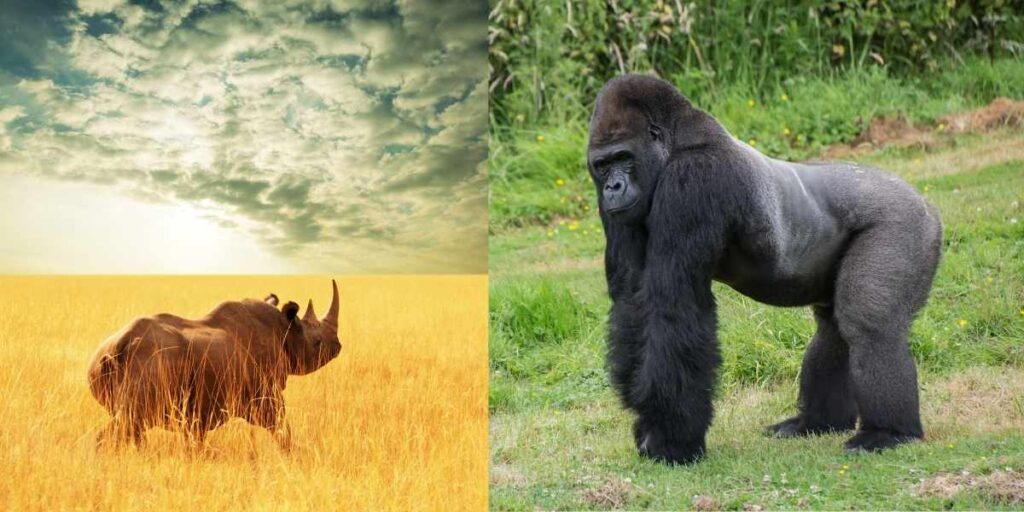The confrontation between a rhino and a gorilla is an epic showdown that captivates the imagination of wildlife enthusiasts. These two powerful creatures embody strength and dominance in the animal kingdom, making a comparison between them an intriguing prospect. In this article, we will delve into the differences between rhinos and gorillas, exploring their strength, size, speed, habitat, and diet. While speculation about a battle between these giants may be thrilling, it is important to remember the significance of protecting these magnificent species in the wild.
10 key differences between Rhinos and Gorillas:
| Feature | Rhino | Gorilla |
|---|---|---|
| Taxonomy | Mammals belonging to the order Perissodactyla. | Primates belonging to the order Primates. |
| Habitat | Found in a variety of ecosystems, from grassy plains to woodlands. | Primarily inhabit tropical forests. |
| Body Structure | Large, thick-set body with a distinctive horn on the snout. | Robust build with a muscular body. |
| Limbs | Three-toed feet with distinct hooves. | Five-fingered hands and feet with opposable thumbs. |
| Diet | Herbivores, with a preference for grasses and other vegetation. | Omnivores, consume a variety of plant and animal matter. |
| Communication | Limited vocalizations, including grunts and snorts. | Extensive vocalizations, including hoots and chest-beating. |
| Social Structure | Generally more solitary, though females may form small groups. | Live in close-knit family groups led by a dominant male. |
| Reproduction | The gestation period is relatively long. | Shorter gestation period compared to rhinos. |
| Grooming Behavior | Limited grooming behavior. | Extensive grooming reinforces social bonds. |
| Conservation Status | Threatened by poaching for horns and habitat loss. | Facing threats such as habitat destruction and poaching. |
Strength: A Battle of Powerhouses
When it comes to strength, both the rhino and the gorilla are formidable opponents, but they possess distinct abilities that set them apart. The rhinoceros, known for its size and armor-like skin, possesses a powerful horn that it can use as a weapon. This horn, made of keratin, can grow up to several feet in length and is capable of inflicting devastating damage. The rhino’s sheer bulk and muscle mass also contribute to its incredible strength, allowing it to charge at impressive speeds and exert immense force.
On the other hand, the gorilla relies on its muscular build and raw power to assert dominance. With their impressive upper body strength, gorillas are capable of executing powerful punches and strikes. They often use their arms for locomotion, allowing them to swing from branches and move with agility through their jungle habitats. Additionally, gorillas possess immense grip strength, enabling them to easily snap branches and manipulate their surroundings. These combined physical attributes make gorillas formidable opponents in any confrontation.
In a hypothetical face-off, the outcome between a rhino and a gorilla would largely depend on the circumstances and the environment. The rhino’s size and horn could give it an advantage in terms of offense, but the gorilla’s mobility and dexterity could allow it to evade and deliver strategic strikes. It is important to note that these scenarios are speculative, as actual battles between these animals are unlikely to occur in the wild. Instead, we should focus on preserving and protecting both the rhino and gorilla populations, appreciating their unique strengths and contributions to the animal kingdom.

| Strengths of the Rhino | Strengths of the Gorilla |
|---|---|
| Large size and formidable horn | Muscular build and raw power |
| Armor-like skin for protection | Agility and mobility in their jungle habitats |
| Powerful charges and forceful impacts | Impressive grip strength and ability to manipulate surroundings |
While a battle between a rhino and a gorilla may capture our imagination, it is important to remember that these incredible animals deserve our respect and conservation efforts. Appreciating their unique strengths and contributions to the natural world enables us to protect and preserve their habitats, ensuring their continued existence for generations to come.
Rhino vs Gorilla Size: Does Bigger Always Mean Better?
In the world of animals, size can often be a determining factor in establishing dominance. Let’s examine how the size of a rhino and a gorilla impact their chances in a face-off.
The rhinoceros is an impressive creature, known for its massive size and intimidating presence. Adult rhinos can weigh up to 2 tons and stand as tall as 6 feet at the shoulder. Their massive bodies are covered in thick, armor-like skin, offering protection against potential attackers. In contrast, gorillas are relatively smaller, with adult males weighing around 400 to 500 pounds and standing about 5.6 to 6 feet tall. Despite their smaller stature, gorillas possess incredible strength and are capable of inflicting serious harm.
While size can provide advantages in terms of sheer force and intimidation, it is not always a determining factor in a battle between animals. Gorillas are known for their agility and dexterity, which allow them to use their strength effectively. On the other hand, rhinos have their powerful horn, which can be a formidable weapon in combat. However, the ability to utilize their size and strength effectively in a face-off is dependent on various factors such as the environment, tactics, and individual temperament.
In conclusion, while the size of a rhino may make it appear more dominant, we must not underestimate the agility and strength of a gorilla. Both animals possess unique characteristics that make them formidable in their own right. In a hypothetical showdown, the outcome would most likely depend on a combination of factors, including the individual temperament of the animals and the circumstances of the encounter. It is important to remember that these animals are not pitted against each other in nature, but rather coexist within their respective habitats. Our admiration for their strength and power should extend to the conservation and protection of both species.
Rhino vs. Gorilla Speed: The Need for Agility
Speed is a crucial aspect in any battle, and both the rhino and the gorilla possess unique attributes that contribute to their agility. While the rhino is not known for its speed, it surprises many with its surprising bursts of acceleration. Despite their massive size, rhinos can reach speeds of up to 35 miles per hour. This allows them to charge at enemies or escape from potential threats in a short burst of energy.
On the other hand, gorillas are incredibly agile despite their muscular build. They exhibit remarkable speed and agility when climbing trees or swinging from branches. Their strong arms and long limbs enable them to move swiftly through their natural habitat. Gorillas can cover ground quickly, reaching speeds of up to 20 miles per hour, especially when moving in a bipedal motion.
Both animals utilize their different forms of agility in different ways. While rhinos rely on their speed to charge through their enemies with remarkable force, gorillas employ their agility to navigate the dense vegetation of their forest habitat and to climb trees when needed. These unique adaptations enable them to survive and thrive in their respective environments.
| Rhino | Gorilla |
|---|---|
| Rhinos can reach speeds of up to 35 miles per hour. | Gorillas can reach speeds of up to 20 miles per hour. |
| They use their speed to charge at enemies or escape potential threats. | They utilize their agility to navigate their forest habitats and climb trees. |
In conclusion, speed and agility play crucial roles in the lives of both the rhino and the gorilla. While the rhino relies on its bursts of acceleration and the gorilla relies on its ability to swiftly move through its natural habitat, both animals demonstrate impressive adaptations that aid them in their survival. The battle between a rhino and a gorilla, though speculative, would showcase the unique strengths and strategies each animal possesses.

The habitat in which an animal lives plays a vital role in its physical characteristics and survival strategies. Let’s discover how the rhino and the gorilla’s habitats impact their potential battle. The rhinoceros, native to the grasslands and savannahs of Africa and Asia, is well-adapted to these open and dry environments. Their thick, armor-like skin protects them from the harsh elements and potential predators. With their strong legs and agile bodies, rhinos can navigate through the grasslands with ease, making them formidable opponents in any battle.
On the other hand, gorillas inhabit the dense forests of Central Africa. These forests provide the gorillas with ample vegetation for their herbivorous diet and offer them protection from larger predators. The dense foliage allows gorillas to maneuver swiftly and silently, making them highly elusive and difficult to track. Their muscular bodies and strong arms make them adept climbers, allowing them to swing from trees and move effortlessly among the branches.
While the rhino’s open habitat gives it an advantage in terms of visibility and maneuverability, the gorilla’s forest setting offers it camouflage and the ability to strike from unexpected angles. The differing terrains in which these animals reside greatly influence their battle strategies and tactics. A rhino may rely on its size and brute strength, while a gorilla may utilize its agility and ability to blend into its surroundings.
Habitat Comparison:
| Rhino | Gorilla |
|---|---|
| Grasslands and savannahs | Dense forests |
| Open and dry environments | Abundant vegetation and protection |
| Thick, armor-like skin | Muscular bodies and strong arms |
| Strong legs for maneuvering through grasslands | Adept climbers and agile in trees |
“The rhino may have the advantage in an open habitat, but the gorilla’s forest setting gives it the upper hand. It’s a battle between strength and stealth, and the outcome is unpredictable.”
In conclusion, the rhino and the gorilla are both uniquely adapted to their respective habitats, and these environments greatly impact their physical capabilities and survival strategies. While the rhino thrives in open grasslands, the gorilla excels in the dense forests. Ultimately, the outcome of a battle between these magnificent creatures would depend on multiple factors, including their individual strengths, strategies, and a fair bit of luck. It is essential to appreciate and protect the natural habitats of these incredible animals to ensure their continued existence in the animal kingdom.
Rhino vs Gorilla Diet: Fueling the Battle
Proper nutrition is essential for any animal to maintain optimal strength and health. Let’s examine the contrasting diets of the rhino and the gorilla and their impact on their preparedness for a battle.
The rhinoceros, with its massive size and herbivorous diet, relies on the consumption of various plant materials to meet its nutritional needs. These formidable creatures primarily feed on grasses, leaves, fruits, and shoots. Their strong, flat teeth enable them to chew and extract nutrients from fibrous vegetation. Rhinos have a unique digestive system that allows them to ferment their food effectively, extracting maximum nutrition from their plant-based diet. They consume large quantities of vegetation to obtain the energy required to sustain their hefty bodies.
In contrast, the gorilla follows an herbivorous diet, predominantly consisting of leaves, stems, and fruits. Gorillas are characterized as folivores, meaning they consume a significant amount of foliage. Their powerful jaws and large molars aid in breaking down tough plant matter. Gorillas have a preference for low-calorie, fibrous vegetation, which provides them with essential nutrients, including vitamins and minerals. Their diet also includes seasonal fruits, which offer additional nutritional value and variety.
While both the rhino and the gorilla have unique dietary requirements, their contrasting diets reflect their distinct adaptations to their environments. A rhino’s herbivorous diet allows it to thrive in grasslands and savannas, whereas a gorilla’s diet is more suited to its forest habitat. These dietary differences play a crucial role in their physical condition and overall combat readiness.

In conclusion, the diets of both the rhino and the gorilla are tailored to their respective needs and environments. Their nutritional intake plays a vital role in fueling their bodies and preparing them for any potential battle. Understanding their dietary requirements not only enhances our knowledge of these magnificent creatures but also highlights the importance of protecting their habitats and food sources.
What can beat a Rhino in a fight?
Conclusion
While the outcomes of a hypothetical battle between a rhino and a gorilla may never be known, it is evident that both animals possess unique strengths and characteristics that make them awe-inspiring creatures of the wild.
The rhinoceros, known for its size and armor-like skin, possesses a powerful horn that can be a formidable weapon. With its massive size and ability to charge at high speeds, it can overpower many predators. On the other hand, gorillas are incredible in their own right. Their sheer strength and agility, combined with their intelligence and complex social structures, make them one of the most fascinating animals in the animal kingdom.
While a rhino may have the advantage in terms of size and physical prowess, a gorilla’s intelligence and adaptability could provide a strategic edge. Gorillas are known to be highly resourceful and have been observed using tools in their natural habitat. In a battle scenario, a gorilla’s ability to plan and strategize could potentially level the playing field against the rhino.
Ultimately, it is crucial to recognize and protect both rhinos and gorillas, as well as all species in the animal kingdom. Each animal contributes to the ecosystem in its own unique way and plays an important role in maintaining biodiversity. Rather than imagining battles between these awe-inspiring creatures, let us appreciate and support efforts to conserve and protect them in the wild.


